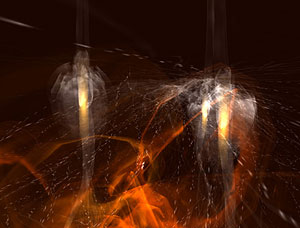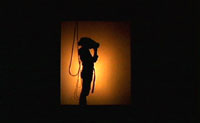Once again, Char Davies is leaving people speechless. Visitors to "Ephémère," Davies's new work of virtual-reality art, exit the installation unable to communicate, as if they had been in another world. Which, in a way, they were. "People were being quite emotionally overcome," Davies said in a telephone interview a few days after the work's June 26 premiere at the National Gallery of Canada in Ottawa, "but I don't really have anybody's response because none of them could talk." As further evidence of Davies's power to create a computer-generated environment that is as intensely involving as it is aesthetically effective, visitors are reporting that their 15 minutes in "Ephémère" seem to pass in two or three, even though they must wear a clunky headset to be plunged into the simulated 3-D cosmos.
Davies, who is based in Montreal, is among the few artists working in virtual reality, a medium usually found in theme parks and game arcades, where paying customers can help defray the hefty development costs and low-tech museum executives don't have to sweat over complex equipment. At its best, VR is an immersive experience that momentarily replaces one's surroundings and can give a heightened sense of consciousness; conversely, it can feel like a gimmick that will never transcend its inherent artificiality.
Feminist and queer-or estranged-politics in digital environments use this meeting of a collectivity of media (by definition multimedia) to shock us, as a means of social critique and commentary, and to engage us in conversation. Using the mainstream media's tools against itself, feminist Virtual Realty artists Charlotte Davies and Brenda Laurel and Rachel Strickland incorporate everyday sensations and make them strange and new through startling juxtapositions that affect us on the level of sensation. This is a synaesthesia so tactile that it stings the eyes, ears and mind simultaneously. Situated knowledges like these are Donna Haraway's call for a feminist "embodied objectivity" (189) that allows for a "particular and specific embodiment" with a physically grounded perspective providing truer insights (190). To this end, Laurel and Strickland and Davies all set out to create exploratory environments that alter the way we inhabit our physical bodies.
"Ephémère" is Davies's first VR work since 1995's Osmose, which elicited similar reactions from its viewers -- Davies calls them "immersants" -- when the piece was shown in Montreal, New York and London. Davies asserted that "Ephémère" is not just more interactive than the earlier work, but a hundred times more visually detailed. To address its key theme, it would have to be. Davies said the new work is about "the ephemerality of life," a simple description akin to James Joyce's calling Ulysses the story of a routine day in Leopold Bloom's life. Time is the focus of "Ephémère," so its abstract universe is in constant flux. "Osmose" was about space, allowing viewers to drift through a vast dreamscape composed of a forest, clouds, a grid of words and other elements that emerged from Davies's painterly imagination. "Once we put those things in ['Osmose'], they didn't change," Davies explained. "In 'Ephémère,' rather than creating worlds with objects in them, every single object is coming, lingering or going."
At the threshold to "Ephémère," the immersant sees a black background flecked with white specks that might be stars in a sky. As they fall, fog rolls in and day breaks. Pale gray trees that have been rendered in calligraphic strokes emerge from the mist as snowflakes flutter down. Night returns, then dawn again. This time, winter's icy palette yields to spring's browns and greens. Rushing water can be heard, and the voyage commences. The viewer is then free to traverse the three levels of "Ephémère." Below this first landscape is Earth, a sienna-hued universe shot through with blue- green roots and dense with stones. The airborne specks return, this time as seeds that, if stared at long enough, will sprout and explode into blinding light. During the descent to the next level, the Body, the rocks start to throb and become pulsating organs. Lush, red corpuscular flecks materialize. (Do not expect a scientific depiction of viscera; like the other environments, this one is not representational.) Descend again and the initial level reappears. A river is present in all three environments, although it is portrayed as a blood vessel in the body. One way to navigate "Ephémère" is to stay on the waterway, for it will shift immersants randomly from one level to another. "It's quite magical," Davies said.
The one unchanging element in "Ephémère" is, of course, change. Even immersants who flit back and forth between levels will find them altered upon their return. And Davies vowed that a viewer who opted to spend the full 15 minutes on one level "would be surrounded constantly by change." Each environment proceeds toward its own conclusion. The landscape becomes autumnal. The earth begins to resemble embers. The body's organs turn to bones, then shafts of light. In all three realms, the seed-like specks make a final appearance. Time has run out.
To experience "Ephémère," the immersant enters a darkened chamber and dons a VR rig consisting of a short vest and a headset outfitted with small stereoscopic video displays. Sensors monitor changes in balance and breathing. Tilting forward and inhaling, for example, will propel the immersant ahead and up in the VR environment. "The interface is a way to ground people in their body during the experience," said Davies, who rode horses competitively in her youth and is a veteran scuba diver. Viewers in an adjacent room can watch the immersant's journey as it is projected on a screen. Another screen displays the silhouette of the headset-encased viewer, making the work a performance as much as a participatory event. Sound is integral to "Ephémère." Rick Bidlack, a composer, and Dorota Blaszczak, a sonic engineer, whipped up an impressionistic, digitally-created audio environment that responds in real time to the viewer's behavior. Musical ripples, for example, might be heard as the immersant nears a stream, with the audio positioned in three-dimensional space in accordance with the viewer's physical orientation.
Davies's other collaborators at Immersence Inc., the firm she founded to pursue her VR artistry, are John Harrison, who developed custom software for the project, and Georges Mauro, a graphics expert. "Ephémère" is based on SoftImage's 3-D modeling software and runs on a powerful Silicon Graphics workstation. "Ephémère" is dedicated to Davies's brother, Michael, who was killed in a car accident in 1988, and to her aunt, Adèle Davies Rockwell, one of Canada's leading horsewomen, who passed away a few days before the exhibit opened. "I thought it was particularly fitting to have such dedications when the work is about the ephemerality of life," Davies said. But is it a sad work? "I don't know," Davies mused before decisively replying, "No, I think people find it very, very joyous. I didn't mean it to be sad. It's more about how everything is passing through, including us, and we should enjoy the splendor of it while we're here because we're not here for very long."
When immersants emerge from "Ephémère," they encounter a loud reminder of the real world. At a desk outside the viewing space, a phone rings continuously as people try to make reservations to view the work. Only 25 to 30 a day are accepted, and the exhibit is scheduled to close Sept. 7. Many slots are already filled weeks in advance. Although Davies would like to have the work exhibited in New York, museums and galleries there have yet to express an interest in showing "Ephémère." This non-virtual reality does not leave Davies speechless. Noting that photography and video art were also slow to be recognized, Davies said: "I'm just a little ahead of what's accepted. I have no doubt that this will eventually be recognized as an art form."
Related Sites
Following are links to the external Web sites mentioned in this article. These sites are not part of The New York Times on the Web, and The Times has no control over their content or availability. When you have finished visiting any of these sites, you will be able to return to this page by clicking on your Web browser's "Back" button or icon until this page reappears.
EphémèreNational Gallery of Canada
Osmose
Immersence Inc.
Near the entrance to "Ephémère" is an inscription that Davies selected from the Ninth Duino Elegy by the poet Rainer Maria Rilke.
This article may include minor changes from the original publication in order to improve legibility and layout consistency within the Immersence Website. † Significant changes from the original text have been indicated in red square brackets.

